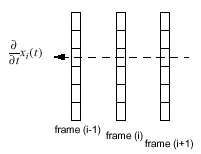ADDING TEMPORAL INFORMATION: DERIVATIVES
- We would like to add information about the change in the spectrum
to our feature vector to improve our ability to distinguish between
stationary sounds (vowels) and nonstationary sounds
(consonants).
- Recall the definition of differentiation in the time domain:

- Differentiation is an inherently noisy process since it
amplifies high frequencies. Hence, we must be careful how we
compute this. In practice, we use low-pass filtered derivatives
(the derivative of a low-pass filtered version of the signal).
- What we really want to measure is the time derivative of the
spectrum:
 But derivatives of continuous time signals are difficult
to compute for discrete-time signals.
But derivatives of continuous time signals are difficult
to compute for discrete-time signals.
- Recall the definition of a derivative:
 This can be viewed as a digital filter:
This can be viewed as a digital filter:
 Later we will explore the frequency response of this filter.
Later we will explore the frequency response of this filter.

- In practice, we compute temporal derivatives of feature vectors
by differentiating each element as a function of time. Since
feature vectors measure the spectrum, this gives us a realistic
measure of spectral change. These derivatives, called delta
parameters, are concatenated with the absolute measurements to
form an extended feature vector that contains absolute and rate
of change information.









